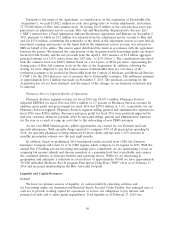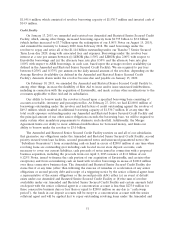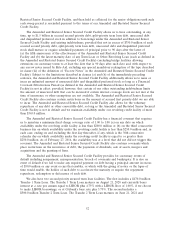Rite Aid 2016 Annual Report Download - page 60
Download and view the complete annual report
Please find page 60 of the 2016 Rite Aid annual report below. You can navigate through the pages in the report by either clicking on the pages listed below, or by using the keyword search tool below to find specific information within the annual report.If our actual future cash flows differ from our projections materially, certain stores that are either
not impaired or partially impaired in the current period may be further impaired in future periods. A
50 basis point decrease in our future sales assumptions as of February 27, 2016 would have resulted in
an additional fiscal 2016 impairment charge of $1.6 million. A 50 basis point increase in our future
sales assumptions as of February 27, 2016 would have reduced the fiscal 2016 impairment charge by
$0.4 million. A 100 basis point decrease in our future sales assumptions as of February 27, 2016 would
have resulted in an additional fiscal 2016 impairment charge of $4.5 million. A 100 basis point increase
in our future sales assumptions as of February 27, 2016 would have reduced the fiscal 2016 impairment
charge by $0.8 million.
Revenue recognition for our loyalty program: We offer a chain wide customer loyalty program,
‘‘wellness+’’. Members participating in our wellness+ loyalty card program earn points on a calendar
year basis for eligible front end merchandise purchases and qualifying prescriptions. One point is
awarded for each dollar spent towards front end merchandise and 25 points are awarded for each
qualifying prescription.
Members reach specific wellness+ tiers based on the points accumulated during the calendar year,
which entitle them to certain future discounts and other benefits upon reaching that tier. For example,
any customer that reaches 1,000 points in a calendar year achieves the ‘‘Gold’’ tier, enabling the
customer to receive a 20% discount on qualifying purchases of front end merchandise for the
remaining portion of the calendar year and the next calendar year. There are also similar ‘‘Silver’’ and
‘‘Bronze’’ levels with lower thresholds and benefit levels.
As wellness+ customers accumulate points, we defer the value of the points earned as deferred
revenue based on the expected usage. The amount deferred is based on historic and projected customer
activity (e.g., tier level, spending level). As customers receive discounted front end merchandise, we
recognize an allocable portion of the deferred revenue. If the achieved combined Gold, Silver, and
Bronze levels differ from the assumptions by 5.0% it would have affected pretax income by
$1.3 million. If the assumed spending levels, which are the drivers of future discounts, differ by 5.0% it
would have affected pretax income by $1.3 million.
Rite Aid has partnered with American Express Travel Related Services Company, Inc. to be part
of a coalition loyalty program titled Plenti. This awards program allows a customer to earn points based
on qualifying purchases at participating retailers. Each Plenti point is worth the equivalent of $0.01.
The customer has the opportunity to redeem their accumulated points on a future purchase at any of
the participating retailers. All points are redeemed using a FIFO methodology (e.g., first points earned
are the first to be redeemed). Points expire on December 31st of each year for any point that has aged
a minimum of two years that has not been redeemed by the customer.
For a majority of the Plenti point issuances, funding is provided by our vendors through
contractual arrangements. This funding is treated as deferred revenue and remains in deferred revenue
until a customer redeems their points. Upon redemption, the deferred revenue account is decremented
with an offsetting credit to sales. For Plenti point redemptions that are not vendor funded, deferred
revenue is recorded and not recognized until the points are redeemed.
Self-insurance liabilities: We expense claims for self-insured workers’ compensation and general
liability insurance coverage as incurred including an estimate for claims incurred but not paid. The
expense for self-insured workers’ compensation and general liability claims incurred but not paid is
determined using several factors, including historical claims experience and development, severity of
claims, medical costs and the time needed to settle claims. We discount the estimated expense for
workers’ compensation to present value as the time period from incurrence of the claim to final
settlement can be several years. We base our estimates for such timing on previous settlement activity.
The discount rate is based on the current market rates for Treasury bills that approximate the average
time to settle the workers’ compensation claims. These assumptions are updated on an annual basis. A
60
























